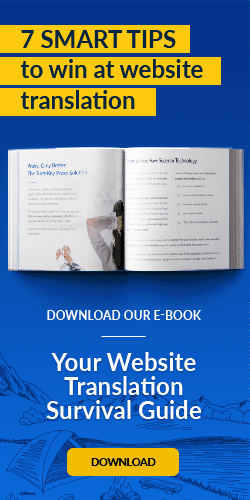The value of website translation becomes very apparent, very quickly, when your company expands into global markets. Your new customers won't visit a site they can't read.
But website translation isn't easy. You need to know the key challenges, and best practices, of the process. Here's a quick survival guide.
Three Pitfalls to Avoid
Newcomers can't fathom the problems that can sidetrack or outright derail a website translation project. Here are three common "gotchas" to be aware of:
#1: Multilingual CMS Features Aren’t Enough
Your CMS probably has multilingual features that claim to easily manage translated content. Unfortunately, most of those features are undercooked. They often demand unexpected effort and resources to maintain.
For instance, multilingual CMSs rarely have automated translation workflows, which forces your team to manually manage the process of finding on-site translatable content, sending it off to translators, and integrating the translated material into the localised website.
This process is time-consuming, prone to error, and ultimately expensive.
#2: You Don’t Consider the Opportunity Cost
If you're thinking about using an in-house team to translate your site, the headaches you'll inherit will quickly outpace the cost of hiring a great website translation vendor. Here are a few:
- Hiring new personnel to manage translations and websites
- Translating text, images, metadata, multimedia content and applications
- Ensuring the accuracy of translations
- QA’ing translated content for on-site design issues
#3: Vendor Danger: Maximising Translation Expense
Choosing a vendor is its own special kind of minefield. Partnering with a decades-old vendor sounds like a safe play, but those companies often operate under legacy business models.
This means they generate revenue by charging by the translated word. They have little or no incentive to reduce your costs.
Low price-per-word translation pricing is risky, too. Low prices may be reflected in poor translation quality, or might distract you from unseen costs associated with editing and project management.
Four Best Practices to Embrace
Choosing the right translation partner isn't as hard as it sounds, if you remember that the goal is to remove the burden and expense of translation and site maintenance from your marketing team's shoulders. Great vendors do this without sacrificing translation quality, speed, flexibility or cost savings.
#1: Choose a Solution that Minimises Complexity and Cost
With so much at stake, it’s essential to choose a website translation approach that delivers a world-class experience for your global customer without overtaxing your in-house team.
Proxy-based website translation solutions can do that. They operate independently of your website, making translation and operation effort-free for you. The best solutions are also flexible, enabling your marketing team to be as hands-on (or hands-off) with the process as it wishes.
#2: Supports Multichannel Translation
Your company’s marketing efforts extend far beyond your website—reaching into social media, email, product feeds, offline documents, and more.
Your vendor should offer omnichannel translation services that deliver translation quality and consistency across all channels. It should also have APIs and other solutions on-hand to enable you to submit multichannel content for translation any time you wish.
#3: Supporting Localisation
While traditional translation is a great way to serve global customers, region-specific translations and cultural nuances called localizations can add a big boost to engagement and conversions. They increase the likelihood of your brand being fully understood and accepted.
If you want to convey your brand’s authenticity to new customers, using a solution that leverages localizations makes a big difference.
#4: Supporting All On-Site and Third-Party Content
Few things can be as damaging your globalization effort than a "mixed language" experience on a localised website, where content remains untranslated. It puts your brand's commitment to global markets in question-as well as your competence.
It can even land you in hot water with local regulatory agencies that may require certain content to be presented in a specific way.
Great translation vendors are aware of these issues, and cannot only to translate all content on your flagship website, but also translate content that "lives" on third-party servers or in apps, image files, or metadata.
Conclusion
It’s critical to choose a great vendor whose solution sidesteps the common pitfalls of website translation, and embodies its best practices.
The best translation vendors eliminate effort for you, and deliver world-class translations across all your marketing channels.
Last updated on September 29, 2017
